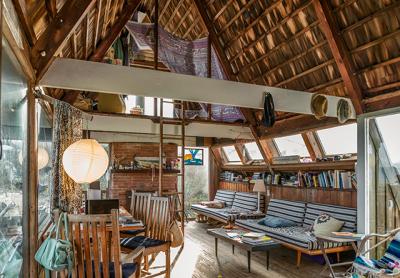A Funky Modernism

Andrew Geller’s uninhibited, angular houses of the 1950s and 1960s were cut from a playful mold. He was known as “the architect of happiness,” having designed the prefabricated Leisurama houses marketed for middle-income families by Macy’s, which came fully furnished. For as little as $590 down and $73 a month — or somewhat more if you splurged — you could take your toothbrush, buy groceries, and enjoy the summer, even at Montauk, where some 200 were built. To his detractors, Geller was an outsider, but it was a concept he relished.
Alastair Gordon, the architectural historian and author who contributed articles on design to The East Hampton Star and its supplements in the 1980s and ’90s, is a Geller aficionado. In his book “Beach Houses” he describes Geller’s work as “more in the spirit of pop culture than high culture, orbiting the refined culture of Architecture with a capital A.”
Many Geller houses on eastern Long Island have, like numerous Leisuramas, been remodeled beyond recognition, while others were torn down or swept away by the sea. His famous Pearlroth House in Westhampton — two diamond-shapes perched on end — has become a museum. But at least one house, high on a dune on Marine Boulevard in Amagansett, is still owned by the family for which it was built and stands true to its original form.
Devotees of the Showtime hit series “The Affair” will be familiar with the house. The lead character, Alison Lockhart, lived there, although the script alleged the house was in Montauk.
Geller’s quixotic style is described in “Beach Houses,” which was written after Mr. Gordon joined the architect in his vintage yellow Mercedes on a hot July day about 15 years ago on a quest to see any that could still be found. An excerpt follows:
“It is the small, oddly shaped house that he designed for Leonard and Helen Frisbie back in 1958. It sits in its own kind of time warp, perched at the very top of the dune, like some weather-beaten artifact washed ashore in a storm. . . . It is a simple geometric shape: a sharply slanted roof with large windows overlooking the ocean and a small deck reaching over the ridge of the dune. It is the color of driftwood, with its cedar shakes curled back like fish scales, and the board-and-batten siding along the low-lying sidewalls. It is the most rudimentary sort of shelter, more like a campsite than a house — the beach house dream realized. The price, back in 1957, was less than $10,000. . . .”
“Inside, the house is spartan and conspicuously low tech. . . . You can even see openings in the ceiling where daylight shines through cracks in the old shingles. Most of the living happens on the outside, out on the broad sun deck or on the beach itself. Upstairs there are a few tiny bedrooms with bunk beds. A single indoor/outdoor shower serves the whole family. There is a simple wood flap along the kitchen counter that can be raised to become an extra table. Then there is the ingenious system of ladders that lead to the loft spaces and can be pulled up or down by a rudimentary system of pulleys and lead counterweights.”
In “The Affair,” the house was supposed to have burned down but in real life the Frisbie family still owns and enjoys it from June through September.
Matt Frisbie grew up in Sag Harbor but spent every summer at the oceanfront house with his family and grandparents, for whom the house was built.
“It was a simple concept,” Mr. Frisbie said. “You didn’t have to be wealthy to live on the ocean. It was inexpensive to build. There’s no heat, no insulation, no swimming pool, or media room. Just the basics.”
While much of the Hamptons revs up for the season, the Frisbies scale back. “We go to bed slightly after dark, we play board games, collect shells, and swim five times a day,” he said, adding that it was his grandfather’s wish for the house to remain in the family. So far, so good. It is something the Frisbies hope for, too.
With reporting by Helen Rattray. Photographs courtesy of Big Magazine
